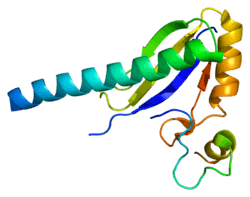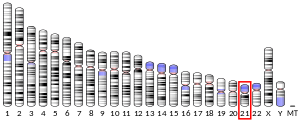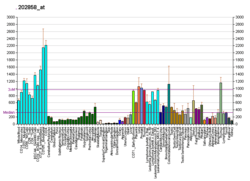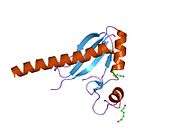U2 small nuclear RNA auxiliary factor 1
Splicing factor U2AF 35 kDa subunit is a protein that in humans is encoded by the U2AF1 gene.[3][4][5]
Function
This gene belongs to the splicing factor SR family of genes. U2 auxiliary factor, comprising a large and a small subunit, is a non-snRNP protein required for the binding of U2 snRNP to the pre-mRNA branch site. This gene encodes the small subunit which plays a critical role in both constitutive and enhancer-dependent RNA splicing by directly mediating interactions between the large subunit and proteins bound to the enhancers. Alternatively spliced transcript variants encoding different isoforms have been identified.[5] Somatic mutations in U2AF1 have been found in a range of human cancers, with a distinctive pattern of these mutations at the zinc fingers implicating a functional role under selection. In lung cancers, these mutations affect alternative splicing of several transcripts, including oncogenic ROS1 fusions.[6]
Interactions
U2 small nuclear RNA auxiliary factor 1 has been shown to interact with:
References
- GRCh38: Ensembl release 89: ENSG00000160201 - Ensembl, May 2017
- "Human PubMed Reference:". National Center for Biotechnology Information, U.S. National Library of Medicine.
- Lalioti MD, Gos A, Green MR, Rossier C, Morris MA, Antonarakis SE (January 1997). "The gene for human U2 snRNP auxiliary factor small 35-kDa subunit (U2AF1) maps to the progressive myoclonus epilepsy (EPM1) critical region on chromosome 21q22.3". Genomics. 33 (2): 298–300. doi:10.1006/geno.1996.0196. PMID 8660980.
- Kalcheva I, Plass C, Sait S, Eddy R, Shows T, Watkins-Chow D, Camper S, Shibata H, Ueda T, Takagi N (Dec 1994). "Comparative mapping of the imprinted U2afbpL gene on mouse chromosome 11 and human chromosome 5". Cytogenet Cell Genet. 68 (1–2): 19–24. doi:10.1159/000133881. PMID 7956352.
- "Entrez Gene: U2AF1 U2 small nuclear RNA auxiliary factor 1".
- Esfahani MS, Lee LJ, Jeon YJ, Flynn RA, Stehr H, Hui AB, et al. (December 2019). "Functional significance of U2AF1 S34F mutations in lung adenocarcinomas". Nature Communications. 10 (1): 5712. doi:10.1038/s41467-019-13392-y. PMC 6911043. PMID 31836708.
- Xiao SH, Manley JL (November 1998). "Phosphorylation-dephosphorylation differentially affects activities of splicing factor ASF/SF2". EMBO J. 17 (21): 6359–67. doi:10.1093/emboj/17.21.6359. PMC 1170960. PMID 9799243.
- Zhang WJ, Wu JY (October 1996). "Functional properties of p54, a novel SR protein active in constitutive and alternative splicing". Mol. Cell. Biol. 16 (10): 5400–8. doi:10.1128/MCB.16.10.5400. PMC 231539. PMID 8816452.
- Zolotukhin AS, Tan W, Bear J, Smulevitch S, Felber BK (February 2002). "U2AF participates in the binding of TAP (NXF1) to mRNA". J. Biol. Chem. 277 (6): 3935–42. doi:10.1074/jbc.M107598200. PMID 11724776.
- Maita H, Kitaura H, Keen TJ, Inglehearn CF, Ariga H, Iguchi-Ariga SM (November 2004). "PAP-1, the mutated gene underlying the RP9 form of dominant retinitis pigmentosa, is a splicing factor". Exp. Cell Res. 300 (2): 283–96. doi:10.1016/j.yexcr.2004.07.029. PMID 15474994.
- Little JT, Jurica MS (March 2008). "Splicing factor SPF30 bridges an interaction between the prespliceosome protein U2AF35 and tri-small nuclear ribonucleoprotein protein hPrp3". J. Biol. Chem. 283 (13): 8145–52. doi:10.1074/jbc.M707984200. PMID 18211889.
- Rual JF, Venkatesan K, Hao T, Hirozane-Kishikawa T, Dricot A, Li N, Berriz GF, Gibbons FD, Dreze M, Ayivi-Guedehoussou N, Klitgord N, Simon C, Boxem M, Milstein S, Rosenberg J, Goldberg DS, Zhang LV, Wong SL, Franklin G, Li S, Albala JS, Lim J, Fraughton C, Llamosas E, Cevik S, Bex C, Lamesch P, Sikorski RS, Vandenhaute J, Zoghbi HY, Smolyar A, Bosak S, Sequerra R, Doucette-Stamm L, Cusick ME, Hill DE, Roth FP, Vidal M (October 2005). "Towards a proteome-scale map of the human protein-protein interaction network". Nature. 437 (7062): 1173–8. doi:10.1038/nature04209. PMID 16189514.
- Zhang M, Zamore PD, Carmo-Fonseca M, Lamond AI, Green MR (September 1992). "Cloning and intracellular localization of the U2 small nuclear ribonucleoprotein auxiliary factor small subunit". Proc. Natl. Acad. Sci. U.S.A. 89 (18): 8769–73. doi:10.1073/pnas.89.18.8769. PMC 50002. PMID 1388271.
- Adams DJ, van der Weyden L, Mayeda A, Stamm S, Morris BJ, Rasko JE (July 2001). "ZNF265--a novel spliceosomal protein able to induce alternative splicing". J. Cell Biol. 154 (1): 25–32. doi:10.1083/jcb.200010059. PMC 2196870. PMID 11448987.
Further reading
- Zhang M, Zamore PD, Carmo-Fonseca M, Lamond AI, Green MR (1992). "Cloning and intracellular localization of the U2 small nuclear ribonucleoprotein auxiliary factor small subunit". Proc. Natl. Acad. Sci. U.S.A. 89 (18): 8769–8773. doi:10.1073/pnas.89.18.8769. PMC 50002. PMID 1388271.
- Zamore PD, Green MR (1991). "Biochemical characterization of U2 snRNP auxiliary factor: an essential pre-mRNA splicing factor with a novel intranuclear distribution". EMBO J. 10 (1): 207–14. doi:10.1002/j.1460-2075.1991.tb07937.x. PMC 452631. PMID 1824937.
- Wu JY, Maniatis T (1994). "Specific interactions between proteins implicated in splice site selection and regulated alternative splicing". Cell. 75 (6): 1061–1070. doi:10.1016/0092-8674(93)90316-I. PMID 8261509.
- Zuo P, Maniatis T (1996). "The splicing factor U2AF35 mediates critical protein-protein interactions in constitutive and enhancer-dependent splicing". Genes Dev. 10 (11): 1356–1368. doi:10.1101/gad.10.11.1356. PMID 8647433.
- Hong W, Bennett M, Xiao Y, Feld Kramer R, Wang C, Reed R (1997). "Association of U2 snRNP with the spliceosomal complex E". Nucleic Acids Res. 25 (2): 354–361. doi:10.1093/nar/25.2.354. PMC 146436. PMID 9016565.
- Tronchère H, Wang J, Fu XD (1997). "A protein related to splicing factor U2AF35 that interacts with U2AF65 and SR proteins in splicing of pre-mRNA". Nature. 388 (6640): 397–400. doi:10.1038/41137. PMID 9237760.
- Wang HY, Lin W, Dyck JA, Yeakley JM, Songyang Z, Cantley LC, Fu XD (1998). "SRPK2: a differentially expressed SR protein-specific kinase involved in mediating the interaction and localization of pre-mRNA splicing factors in mammalian cells". J. Cell Biol. 140 (4): 737–750. doi:10.1083/jcb.140.4.737. PMC 2141757. PMID 9472028.
- Rudner DZ, Kanaar R, Breger KS, Rio DC (1998). "Interaction between subunits of heterodimeric splicing factor U2AF is essential in vivo". Mol. Cell. Biol. 18 (4): 1765–73. doi:10.1128/MCB.18.4.1765. PMC 121406. PMID 9528748.
- Lallena MJ, Martínez C, Valcárcel J, Correas I (1998). "Functional association of nuclear protein 4.1 with pre-mRNA splicing factors". J. Cell Sci. 111 (14): 1963–71. PMID 9645944.
- Gozani O, Potashkin J, Reed R (1998). "A potential role for U2AF-SAP 155 interactions in recruiting U2 snRNP to the branch site". Mol. Cell. Biol. 18 (8): 4752–60. doi:10.1128/mcb.18.8.4752. PMC 109061. PMID 9671485.
- Neubauer G, King A, Rappsilber J, Calvio C, Watson M, Ajuh P, Sleeman J, Lamond A, Mann M (1998). "Mass spectrometry and EST-database searching allows characterization of the multi-protein spliceosome complex". Nat. Genet. 20 (1): 46–50. doi:10.1038/1700. PMID 9731529.
- Xiao SH, Manley JL (1999). "Phosphorylation-dephosphorylation differentially affects activities of splicing factor ASF/SF2". EMBO J. 17 (21): 6359–6367. doi:10.1093/emboj/17.21.6359. PMC 1170960. PMID 9799243.
- de Vries H, Rüegsegger U, Hübner W, Friedlein A, Langen H, Keller W (2000). "Human pre-mRNA cleavage factor II(m) contains homologs of yeast proteins and bridges two other cleavage factors". EMBO J. 19 (21): 5895–5904. doi:10.1093/emboj/19.21.5895. PMC 305781. PMID 11060040.
- Gama-Carvalho M, Carvalho MP, Kehlenbach A, Valcarcel J, Carmo-Fonseca M (2001). "Nucleocytoplasmic shuttling of heterodimeric splicing factor U2AF". J. Biol. Chem. 276 (16): 13104–13112. doi:10.1074/jbc.M008759200. PMID 11118443.
- Adams DJ, van der Weyden L, Mayeda A, Stamm S, Morris BJ, Rasko JE (2001). "ZNF265--a novel spliceosomal protein able to induce alternative splicing". J. Cell Biol. 154 (1): 25–32. doi:10.1083/jcb.200010059. PMC 2196870. PMID 11448987.
- Will CL, Schneider C, MacMillan AM, Katopodis NF, Neubauer G, Wilm M, Lührmann R, Query CC (2001). "A novel U2 and U11/U12 snRNP protein that associates with the pre-mRNA branch site". EMBO J. 20 (16): 4536–4546. doi:10.1093/emboj/20.16.4536. PMC 125580. PMID 11500380.
- Nesic D, Krämer A (2001). "Domains in human splicing factors SF3a60 and SF3a66 required for binding to SF3a120, assembly of the 17S U2 snRNP, and prespliceosome formation". Mol. Cell. Biol. 21 (19): 6406–6417. doi:10.1128/MCB.21.19.6406-6417.2001. PMC 99788. PMID 11533230.
- Esfahani MS, Lee LJ, Jeon YJ, Flynn R, Stehr H, Hui A, Ishisoko N, Kildebeck E, Newman AM, Bratman SV, Porteus MH, Chang HY, Alizadeh AA, Diehn M (2019). "Functional significance of U2AF1 S34F mutations in lung adenocarcinomas". Nature Communications. 10 (1): 1–13. doi:10.1038/s41467-019-13392-y. PMC 6911043. PMID 31836708.




